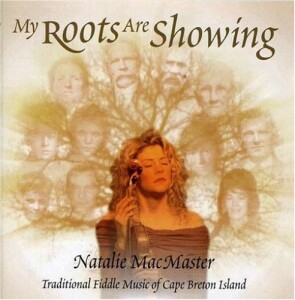 Natalie MacMaster is blessed with extraordinary talent – nurtured by a musical family and honed through fiddle competitions. She is also possessed of perky blonde good looks that seem to cause many a young folkie’s brain to shift into neutral as she is fiddling and step dancing her way through a set – the effect can last for literally hours if my dates are typical.
Natalie MacMaster is blessed with extraordinary talent – nurtured by a musical family and honed through fiddle competitions. She is also possessed of perky blonde good looks that seem to cause many a young folkie’s brain to shift into neutral as she is fiddling and step dancing her way through a set – the effect can last for literally hours if my dates are typical.
Natalie has sold over 400,000 albums – between 30-40 percent of them off the stage, during a relentless touring schedule that runs to 300 shows per year, according to her manager Andre Bourgious in an article on the Atlantic provinces music scene. Although she hosted a radio show in Nova Scotia for a time, she has only recently ventured into singing, and last time I saw her she played on this fact. In her rather nasal voice and Cape Breton brogue, she asked an audience member to take her picture holding a microphone and start spreading the rumor that she had begun singing, and to “Tell them it was great!” For me this was a sign that she has become comfortable with her success in bringing the instrumental music of Cape Breton to the world.
Some of this comfort comes through on My Roots are Showing, an instrumental recording made in 199, and released in the U.S. by Rounder this year. MacMaster showcases the Cape Breton fiddling tradition, giving many of her favorite tunes modern arrangements. Although her shows include a touring band with bass and drum kit, this recording sticks to the traditional arrangement of fiddle, piano, and guitar, with percussion by feet, and occasionally an actual drum. Natalie’s uncle, fiddler Buddy MacMaster, joins her on one set on this album. She is also supported by longtime collaborator and mentor Dave MacIsaac on guitar, with Paul Mills and Gordie Sampson filling in on several numbers. Mathew Foulds contributes snare drum on two sets. A series of players provide the distinctive Cape Breton piano playing, including Joel Chiasson, Mary Jessie MacDonald, Howie MacDonald, and Tracy Dares.
MacMaster’s enthusiasm for this music comes through both in the playing and in the detailed explanations on the liner notes. They explain where the tunes came from, which fiddlers introduced the turns, or variations she plays in sequence, who has recorded them, and tune books in which they appear. This is a fiddle player’s set of liner notes! The liner notes are a wealth of information about Cape Breton fiddling, in that MacMaster names not only other musicians, but also old 78s and home recordings among her sources. She tells when the tunes came on to the Cape Breton scene, paying homage to the fiddlers who introduced the tunes. Perhaps she wants to generate an interest in the tunes that will lead to a Rounder re-mastering of these old recordings, but until then we have MacMaster’s arrangements here on CD.
The Cape Breton style is descended from the eighteenth-century Scottish Highlands, as are many of the tunes, carried over by fiddlers and through tunes preserved in mouth music. A non-technical description would focus on the dark tone, and the sense that the music is about to burst out into a wild melee of notes and bow strokes, yet somehow manages to restrain itself for the sake of the dancers. Cape Breton music is very social, in that it is oriented around dance sets and kitchen parties – good time music that gives less emphasis to memories of war and conflict than its Old World cousins. The piano and steady beat also give this music a lot in common with old time styles south of the border.
So what about the tunes? MacMaster’s playing is technically superb and infectious. She excels on the fast sets of jigs, hornpipes and reels that make up most of the album. I enjoyed all the numbers on this recording, but I would have liked to see the pace slow down in a few more places to give the outstanding dance numbers more distinction. I particularly enjoyed the set entitled “The Balmoral Highlanders,” beginning with a pipe tune of that name, and a set of hornpipes and reels entitled “Captain Keeler.”
By far the most outstanding set on the album is the final, live set entitled “A Glencoe Dance Set,” played with Buddy MacMaster. It communicates more of the excitement of the live shows than any of the other tracks, and to my mind is good evidence that the two should produce a collaborative album. To say these are standouts doesn’t imply that the other numbers aren’t excellent – it’s tough to find standouts because the entire album is so well done.
This album will appeal to fans of Scottish and Cape Breton music, step dancers, fiddlers everywhere, and anyone in search of a lively Celtic instrumental album. If you haven’t seen one of MacMaster’s shows, this disc will give you a sense of what you’re missing – although it lacks the stories, historical anecdotes and humor that add spice to her live performances. MacMaster’s success in the Canadian market has come through hard work and a determination to stay close to her roots – so proudly showcased on this recording. Rounder’s release of My Roots are Showing should introduce her music to the wider audience MacMaster deserves.
(Rounder, 2000)
